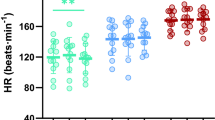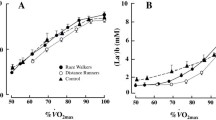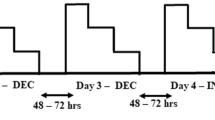Summary
To determine the effects of cycle and run training on rating of perceived exertion at the lactate threshold (LT), college men completed a 40-session training program in 10 weeks (n=6 run training,n=5 cycle training,n=5 controls). Pre-and post-training variables were measured during graded exercise tests on both the bicycle ergometer and treadmill. ANOVA on the pre- and post-training difference scores resulted in similar improvements in\(\dot V_{O_{2max} } \) for both testing protocols, regardless of training mode. The run training group increased\(\dot V_{O_2 } \) at the LT by 58.5% on the treadmill protocol and by 20.3% on the cycle ergometer. Cycle trainers increased\(\dot V_{O_2 } \) LT only during cycle ergometry (+38.7%). No changes were observed in the control group. No differences for RPE at the LT were found before or after training, or between testing protocols for any group. Perception of exercise intensity at the LT ranged from “very light” to “light”. The relationship between RPE and\(\% \dot V_{O_2 \max } \) was altered by the specific mode of training, with trained subjects having a lower RPE at a given\(\% \dot V_{O_2 \max } \) (no change in RPE at max.). It was concluded that RPE at the LT was not affected by training, despite the fact that after training the LT occurs at a higher work rate and was associated with higher absolute and relative metabolic and cardiorespiratory demands.
Similar content being viewed by others
References
American College of Sports Medicine (1986) Guidelines for exercise testing and prescription. Lea and Febiger, Philadelphia
Borg G (1961) Perceived exertion in relation to physical work load and pulse rate. Kungliga Fysiogr Sallsk Lund Forh 31:105–115
Borg G (1962) Physical performance and perceived exertion. Gleerup, Lundi, Sweden
Borg G, Ljunggren G, Ceci R (1985) The increase of perceived exertion, aches and pain in the legs, heart rate and blood lactate during exercise on a bicycle ergometer. Eur J Appl Physiol 54:343–349
Borg G, Hassmen P, Lagerstrom M (1987) Perceived exertion related to heart rate and blood lactate during arm and leg exercise. Eur J Appl Physiol 65:679–685
Boutcher SH, Fleischer-Curtian LA, Gines SD (1988) The effects of self-presentation on perceived exertion. Journal of Sport and Exercise Psychology 10:270–280
Demello JJ, Cureton KJ, Boineau RE, Singh MM (1987) Ratings of perceived exertion at the lactate threshold in trained and untrained men and women. Med Sci Sports Exerc 19:354–362
Denis C, Fouquet R, Poty P, Geyssant A, Lacour JR (1982) Effect of 40 weeks of endvance training on the anaerobic threshold. Int J Sports Med 3:208–214
Dishman RK, Patton RW, Smith J, Weinbeg R, Jackson A (1987) Using perceived exertion to prescribe and monitor exercise training heart rate. Int J Sports Med 8:208–213
Dwyer J, Bybee R (1983) Heart rate indices of the anaerobic threshold. Med Sci Sports Exerc 15:72–76
Ekblom B, Goldbarg AN (1971) The influence of physical training and other factors on the subjective rating of perceived exertion. Acta Physiol Scand 83:399–406
Hagberg JM (1984) Physiological implications of the lactate threshold. Int J Sports Med 5 [Suppl]:106–109
Hellerstein H, Franklin B (1982) Exercise testing and prescription. In: Wegner N, Hellerstein H (eds) Rehabilitation of the coronary patient. Wiley, New York, pp 197–284
Henritze J, Weltman A, Schurrer R, Barlow K (1985) Effects of training at and above the lactate threshold on the lactate threshold and maximal oxygen uptake. Eur J Appl Physiol 54:84–85
Hill DW, Cureton KJ, Grisham C, Collins MA (1987) Effect of training on the rating of perceived exertion at the ventilatory threshold. Eur J Appl Physiol 56:206–211
Katch VL, Weltman A, Sady S, Freedson P (1978) Validity of a relative percent concept for equating training intensity. Eur J Appl Physiol 39:219–227
Mihevic PM (1981) Sensory cues for perceived exertion: a review. Med Sci Sports Exerc 13:150–163
Morgan WP, Hirota K, Weitz G, Balke B (1976) Hypnotic perturbation of perceived exertion: ventilatory consequences. Am J Clin Hypn 18:182–190
Noble BJ (1982) Clinical applications of perceived exertion. Med Sci Sports Exerc 14:406–411
Pandolf KB (1983) Advances in the study and application of perceived exertion. In: Terjung RL (ed) Exercise and sport science reviews, vol 11. Franklin Institute Press, Philadelphia, pp 118–158
Pechar G, McArdle W, Katch F, Magel J, DeLuca J (1974) Specificity of cardiorespiratory adaptations to bicycle and treadmill training. J Appl Physiol 36:753–756
Punvis JW, Cureton KJ (1981) Rating of perceived exertion at anaerobic threshold. Ergonomics 24:295–300
Pierce E, Weltman A, Seip R, Snead D (1988) Effects of specificity of training on the lactate threshold. Med Sci Sports Exerc 20:S38
Rejeski WJ, Ribisl P (1980) Expected task duration and perceived effort: an attributional analysis. J Sport Psychol 2:227–236
Roberts J, Alspaugh L (1972) Specificity of training effects resulting from programs of treadmill running and bicycle ergometer riding. Med Sci Sports Exerc 4:6–10
Robertson RJ (1982) Central signals of perceived exertion during dynamic exercise. Med Sci Sports Exerc 14:390–396
Skinner JS, Borg G, Buskirk ER (1969) Physiological and perceptual reactions to exertion of young men differing in activity and body size. In: Franks BD (ed) Exercise and fitness. The Athletic Institute, Chicago, pp 53–66
Tanaka K, Matsurra Y (1984) Marathon performance, anaerobic threshold and onset of blood lactate accumulation. J Appl Physiol Respir Environ Exerc Physiol 57:640–643
Tanaka K, Nakagawa T, Hazama T, Matsuura K, Asano K, Iseki T (1985) A prediction equation for indirect assessment of anaerobic threshold in male distance runners. Eur J Appl Physiol 54:386–390
Weltman A, Weltman J, Rutt R, Seip R, Levine S, Snead D, Kaiser D, Rogol A (1989a) Percentage of maximal heart rate, heart rate reserve, and\(\dot V_{O_2 \max } \) for determining endurance training intensity in sedentary women. Int J Sports Med (in press)
Weltman A, Snead D, Stein P, Seip R, Schurrer R, Rutt R, Weltman J (1989b) Reliability and validity of a continuous incremental treadmill protocol for the determination of the lactate threshold, fixed blood lactate concentrations and\(\dot V_{O_2 \max } \). Int J Sports Med (in press)
Yoshida T, Suda Y, Takeuchi N (1982) Endurance training regimen based upon arterial blood lactate: effects on anaerobic threshold. Eur J Appl Physiol 49:223–230
Author information
Authors and Affiliations
Rights and permissions
About this article
Cite this article
Boutcher, S.H., Seip, R.L., Hetzler, R.K. et al. The effects of specificity of training on rating of perceived exertion at the lactate threshold. Europ. J. Appl. Physiol. 59, 365–369 (1989). https://doi.org/10.1007/BF02389812
Accepted:
Issue Date:
DOI: https://doi.org/10.1007/BF02389812




